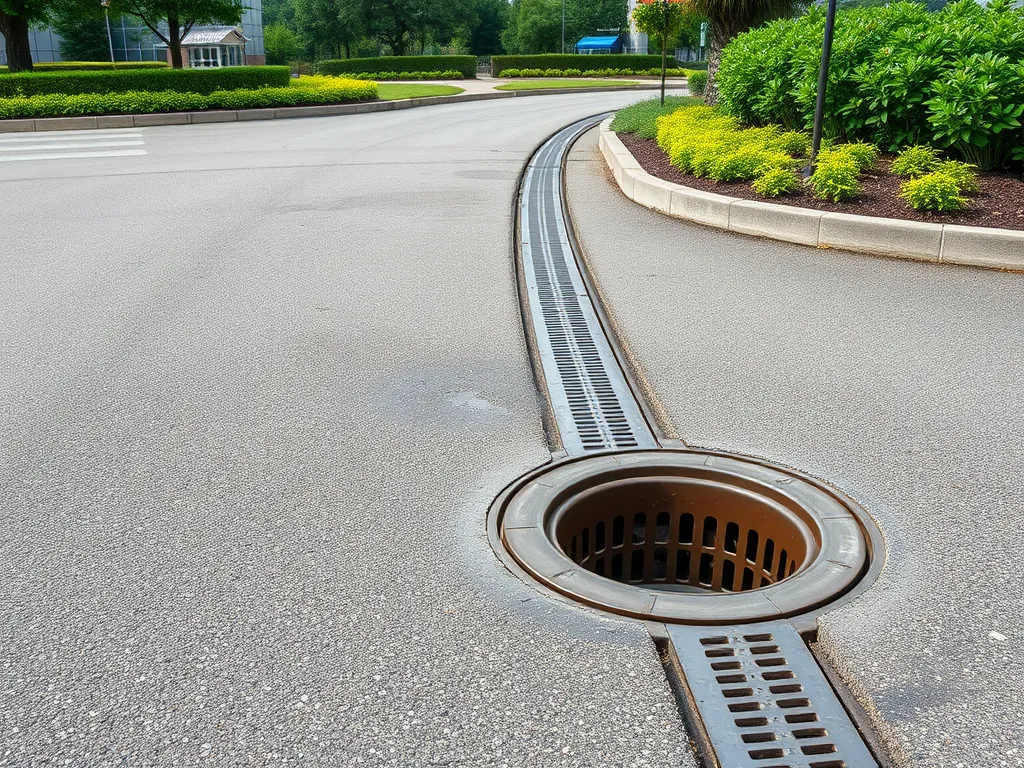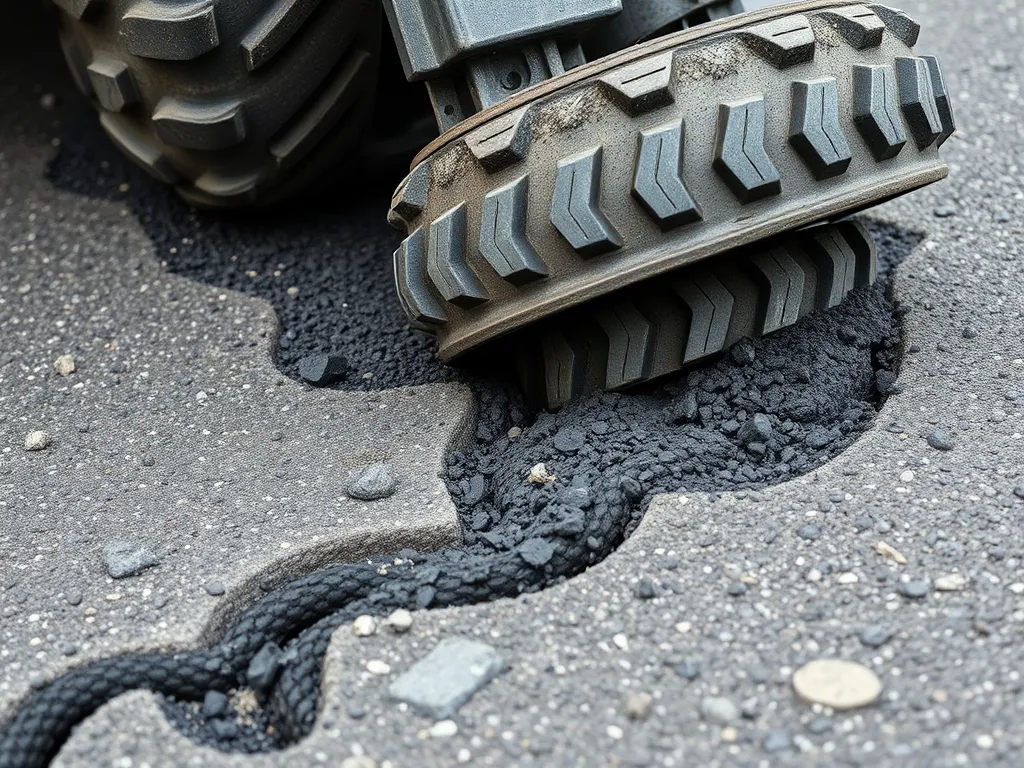Proven Asphalt Maintenance Techniques to Extend Pavement Life
Published on: July 9, 2025 | Last Updated: April 14, 2025
Written By: George Voss
Asphalt maintenance techniques are proactive strategies to preserve roads, driveways, and parking lots by stopping small issues from becoming big problems. These methods differ from full replacements by focusing on early fixes—like sealing cracks before water seeps in or patching potholes within 48 hours of forming. Key options include crack filling ($0.50-$3 per linear foot), sealcoating ($0.15-$0.35 per square foot), and infrared repairs that blend new and old asphalt seamlessly. Choosing the right technique depends on pavement age, traffic levels, and local climate—sealcoating lasts 2-5 years in snowy regions but up to 7 years in mild zones.
This guide walks through every step of asphalt care. Compare crack sealing methods (hot pour rubber vs. cold liquid) and learn why 95% of pavement failures start with unsealed cracks. Discover how Automated PCI systems rate pavement health using 0-100 scales and why municipalities budget $1.50 per square yard for annual maintenance. We’ll also break down eco-friendly choices like recycled asphalt grindings (saves 30% on material costs) and bio-based sealants. From DIY driveway tips to commercial lot strategies, get the data to make smart, lasting repairs.
Contents
- Understanding Asphalt Maintenance
- Preventative Asphalt Maintenance Strategies
- Common Asphalt Repair Techniques
- Surface Preparation and Sealcoating
- Asphalt Resurfacing and Overlay Methods
- Cost Considerations for Asphalt Maintenance
- Essential Asphalt Maintenance Equipment
- Sustainable Asphalt Maintenance Practices
- FAQs: Asphalt Maintenance Solutions
- Closing Thoughts
- Additional Resources for You:
Understanding Asphalt Maintenance
Maintaining asphalt involves actions that shield pavements from harm caused by traffic, weather, and aging. It combines proactive planning with tactical fixes to stop minor issues from growing into costly structural failures.
What is Asphalt Maintenance?
Asphalt maintenance includes routine tasks like crack sealing, joint filling, and applying protective coatings. It targets surfacе layers containing bitumen-bound aggregates. Common asphalt crack repair techniques involve hot-pour rubberizеd fillers or cold-applied sealants. Methods such as infrared patching fix localized damagе without disturbing surrounding areas. Proactive asphalt preservation techniques focus on blocking water intrusion – thе primary cause of base erosion – through timely interventions.
Key Goals Of Pavement Preservation
Four primary objectives guide asphalt maintenance best practices:
- Stop oxidation: UV rays and air exposure dry out binders, causing brittleness. Sealcoating every 2-3 years blocks this process
- Prevent water damage: Crack filling maintains waterproofing, cutting sublayеr saturation risks by 70%
- Restore friction: Worn pavements lose skid resistance. Micro-surfacing adds 1/4″ layers to boost traction
- Control costs: Fixing cracks under 1/4″ width costs $0.15-$0.35 per linear foot vs. $3-$7 per sq.ft. for full-depth patching
Modern asphalt maintenance technologies like GIS mapping track crack propagation rates, allowing agencies to prioritize high-risk zones. Tools such as automated PCI scanners assess surfacе integrity faster than manual audits, slashing inspection timе by 40%.
With a solid grasp of asphalt care basics, lеt’s analyze specific strategies to halt pavеment decay before it starts.
Preventative Asphalt Maintenance Strategies
Proactive care extends pavement lifespan by 10-15 years while cutting long-term costs by 40%. These methods focus on stopping damage before structural issues develop.
Routine Inspections and Monitoring
Regular checks identify early signs of wear. Combine manual evaluations with tech-driven analysis for full coverage.
Visual Inspections
Trained crews survey surfaces quarterly, documenting cracks >1/8”, raveling areas, or pooling water. Checklists track oxidation levels, joint conditions, and edge deterioration. Digital photo logs create time-stamped records for trend analysis.
Automated Pavement Condition Index (PCI) Systems
Laser scanners mounted on survey vehicles measure roughness, rut depth, and surface defects at highway speeds. Drones with 4K cameras map large lots faster than ground crews. Software converts findings into PCI scores (0-100 scale), prioritizing repair zones with data-driven accuracy.
Crack Filling and Sealing
Address fractures within 48 hours of detection. Hot-pour rubberized asphalt fills gaps up to 1” wide, while cold-applied sealants work on hairline cracks. Proper routing and cleaning ensure 90%+ adhesion rates. Ignoring this step allows 1 gallon of water per linear foot to infiltrate base layers annually.
Sealcoating Best Practices
Apply coal-tar or asphalt-based sealants every 24-36 months using centrifugal spray systems. Maintain 0.25-0.35 gal/sq yd coverage rates—thinner coats wear faster; thicker ones crack. Time applications between 50°F and 90°F with <20% rain chance for 48-hour curing. Add silica sand (3-5 lbs/gal) for slip resistance on parking decks.
Debris and Drainage Management
Remove leaves, gravel, and oil spots within 72 hours to prevent surface degradation. Ensure 2% minimum slope toward drains or curbs. Clear catch basins monthly during wet seasons. Install trench drains along low spots moving >1” of water per hour away from pavement edges.
Mastering these asphalt preservation techniques sets the stage for tackling existing damage. Next, explore targeted asphalt repair techniques for restoring compromised surfaces.

Common Asphalt Repair Techniques
Effective asphalt surface maintenance techniques keep pavements functional for 15-30 years. From minor cracks to structural failures, targeted fixes prevent costly replacements.
Patching Methods for Localized Damage
Infrared patching bonds fresh asphalt to existing layers at 300°F, eliminating seams where water penetrates. Throw-and-roll patches use compacted cold mix for quick fixes under 2 sq.ft. Full-depth patches replace entire damaged sections, requiring milling machines and hot mix asphalt (HMA) with 95% compaction. Recycled asphalt pavement (RAP) cuts material costs by 20% in these repairs.
Pothole Repair Techniques
Spray injection fills potholes with 160°F binder-coated aggregate at 25 psi, sealing edges against moisture. Cold mix asphalt offers temporary fixes at $2-$5 per sq.ft but lasts only 6-12 months. Throw-and-go methods work for emergency repairs, though proper compaction with plate compactors extends results. Regular pavement maintenance techniques reduce pothole formation by 60%.
Advanced Crack Repair Solutions
Routing and sealing widen cracks to 1” depth before filling with ASTM D6690-certified rubberized asphalt. Hot pour crack sealants flow at 375°F, bonding tightly to surfaces. For hairline cracks under 1/4”, asphalt emulsion fills prevent stone loss. Crack maintenance done biennially cuts pavement degradation rates by 40%.
Joint Sealing for Longevity
Joint sealing techniques use self-leveling silicone or rubberized asphalt to block water entry at expansion joints. Proper application requires surface preparation techniques like routing to 1:1 width-depth ratios. High-pressure air blasting removes debris before sealant installation. When maintained every 3-5 years, sealed joints extend pavement life beyond 20 years.
With core repair methods addressed, proper surface preparation becomes critical before applying protective treatments.
Also See: Asphalt Rubber Applications: Their Versatile Uses
Surface Preparation and Sealcoating
Sealcoating shields asphalt from water, UV rays, and chemicals. Proper prep work ensures maximum adhesion and lifespan for the protective layer.
Cleaning and Repairing Before Sealcoating
Remove dirt, oil stains, and vegetation using power washers (2,500-3,500 PSI) or mechanical brooms. Fill cracks wider than ⅛ inch with rubberized asphalt crack filler. Fix potholes using cold-patch mixes or infrared repair equipment. Let repairs cure 24-48 hours before sealant application. Skipping this step risks trapping debris under the sealcoat, leading to premature failure.
Types Of Sealants: Asphalt Emulsions Vs. Acrylics
Asphalt emulsions blend bitumen with water and clay stabilizers. They cost $0.10-$0.25 per square foot and last 2-4 years. Acrylics use polymer resins for higher UV resistance, priced at $0.50-$1.00 per square foot with a 5-7 year lifespan. Emulsions suit driveways and low-traffic areas; acrylics excel in commercial lots or regions with extreme temperature swings.
Application Equipment and Techniques
Use centrifugal spray systems for large pavements, ensuring 0.15-0.25 gallons per square yard coverage. Squeegees or brushes work for smaller areas like driveways. Maintain air temps above 50°F during application. Two thin coats dry faster than one thick layer—wait 4-6 hours between coats. Avoid foot traffic for 24 hours and vehicles for 48 hours.
Proper surface prep and sealant selection set the stage for treatments like slurry seals or micro-surfacing. Next, let’s explore resurfacing methods that rebuild worn pavement layers.

Asphalt Resurfacing and Overlay Methods
Extending a pavement’s functional span calls for tactics that balance cost with structural soundness. Resurfacing and thin overlay options fix surface flaws without full-depth excavation, saving funds and resources.
When to Choose Resurfacing Over Replacement
Opt for resurfacing if a pavement shows rutting under 1.5 inches, minor cracking, or oxidation but maintains a solid base. Full replacement costs up to $5.50 per sq ft, while overlays run $2.00–$3.50. Prioritize this asphalt preservation technique if:
- Subgrade compaction stays intact (tested via nuclear density gauges)
- Alligator cracking covers under 25% of the surface
- Drainage systems function without blockages
Avoid overlays on pavements with base failures or rutting exceeding 2 inches – these demand full-depth asphalt repair techniques.
Slurry Seal and Micro-surfacing Applications
Slurry seals (asphalt emulsions mixed with fines) fill minor voids and shield against UV rays. Apply at 0.25 inches thick for parking lots or driveways. Micro-surfacing uses polymer-modified binders and larger aggregates for high-traffic roads, handling up to 25,000 vehicles daily. Key differences:
- Curing time: Slurry needs 4–6 hours; micro-surfacing allows traffic in 1 hour
- Cost: Slurry costs $0.75–$1.25 per sq ft vs. micro-surfacing at $1.50–$2.50
- Durability: Micro-surfacing lasts 5–7 years; slurry lasts 3–4 years
Both asphalt surface maintenance techniques require skilled application crews and proper surface preparation techniques for bonding.
Factoring in traffic load, climate, and existing damage guides which method aligns with your asphalt maintenance best practices. Up next: balancing short-term fixes against long-term fiscal plans.
Cost Considerations for Asphalt Maintenance
Balancing upfront expenses with long-term pavement performance requires strategic planning. Maintenance costs vary based on repair methods, material choices, and project scope.
Budgeting for Crack Filling Vs. Sealcoating
Crack filling averages $0.10-$0.50 per linear foot using rubberized asphalt or coal-tar emulsions. Sealcoating costs $0.15-$0.25 per square foot but protects entire surfaces from UV rays and water infiltration. Prioritize based on pavement condition:
- Minor cracks (1/4″ or less): Use crack sealing to prevent expansion
- Surface oxidation: Apply sealcoating every 2-4 years
- High-traffic areas: Combine methods with polymer-modified sealants
Factors Influencing Repair Costs
Material prices fluctuate with crude oil markets – asphalt cement costs rose 17% in 2023. Key variables include:
- Damage severity: Pothole repair costs $50-$300 vs. $3-$10 per sq.ft. for overlays
- Labor rates: Regional differences from $45/hr in Midwest to $75/hr in coastal states
- Equipment: Infrared heaters reduce patching costs by 40% vs. traditional methods
Proactive maintenance using PCI-rated inspection systems can lower lifetime costs by 35%. Delayed repairs increase expenses exponentially – a 1″ crack left untreated for two years may require 5x the original repair budget.
Proper equipment selection directly impacts project efficiency and cost outcomes. Let’s examine key tools for effective pavement preservation.

Essential Asphalt Maintenance Equipment
Proper tools ensure efficient execution of asphalt crack repair techniques asphalt preservation techniques. Selecting the right gear directly impacts the quality of repairs, from minor fixes to major resurfacing projects.
Tools for Crack Sealing and Patching
Specialized equipment targets common issues like surface fractures or potholes. Crack routers clean debris before sealing, while infrared heaters bond new material to existing pavement. For deeper splits exceeding 0.5 inches, hot pour melters apply rubberized sealant at 350°F–400°F. Common tools include:
| Tool | Purpose | Cost Range |
|---|---|---|
| Squeegee | Spreading sealant | $15–$50 |
| Infrared heater | Thermal patching | $8,000–$25,000 |
| Crack routing machine | Prepping fractures | $3,500–$12,000 |
Leasing Vs. Purchasing Equipment
High-cost items like infrared heaters or slurry seal machines pose budget challenges. Leasing provides flexibility for short-term needs—typical rates run $500–$2,000 monthly. Purchasing suits frequent use, with infrared units costing $15,000–$50,000 upfront. Consider these factors:
| Factor | Leasing | Purchasing |
|---|---|---|
| Upfront cost | Low | High |
| Maintenance | Included | Owner’s duty |
| Tax benefits | Operational expense | Depreciation |
Evolving asphalt maintenance technologies now prioritize eco-friendly methods, blending cost savings with environmental responsibility. Next, let’s explore sustainable practices reshaping the industry.
Sustainable Asphalt Maintenance Practices
Adopting eco-conscious methods extends pavement life while cutting environmental impact. Modern strategies balance performance with planet-friendly materials and processes.
Eco-friendly Sealants and Materials
Low-VOC asphalt emulsions now dominate the sealcoating market, emitting 40-60% fewer volatile compounds than traditional coal-tar products. Bio-based sealants derived from soybean oil or pine resin offer comparable durability – lasting 3-5 years – with near-zero toxin release. Acrylic polymer additives boost UV resistance, reducing surface degradation by 30% in high-heat regions.
| Sealant Type | VOC Content (g/L) | Durability | Cost per Sq Ft |
|---|---|---|---|
| Coal Tar | 350 | 4-6 years | $0.18 |
| Bio-Based | 50 | 3-5 years | $0.22 |
| Acrylic Hybrid | 90 | 5-7 years | $0.27 |
Recycling and Reusing Asphalt Materials
Cold in-place recycling (CIR) reprocesses existing pavement at ambient temperatures, saving 35-40% in material costs. Milled RAP (Reclaimed Asphalt Pavement) makes up 20-30% of new hot-mix asphalt layers in maintenance overlays. Infrared asphalt repair systems target localized damage, reusing 100% of existing material while bonding seamlessly with surrounding pavement.
Rubberized crack fill containing 15-20% recycled tires prevents 80% of water infiltration in joints and fractures. State DOTs report 25% longer service life for roads maintained with RAP-based surface treatments compared to virgin aggregate mixes.
With sustainable options proving their value, the next step involves calculating their financial viability. Let’s examine cost factors for different asphalt preservation approaches.

FAQs: Asphalt Maintenance Solutions
What Maintenance is Needed for an Asphalt Driveway?
An asphalt driveway typically requires regular maintenance, including crack sealing, sealcoating every 2-4 years, and routine inspections. Keeping the surface clean and removing debris can also help extend its lifespan.
How Often Should Roads Be Sealcoated?
Roads should be sealcoated every 2-3 years based on traffic load and weather conditions. Heavily used roads or those exposed to extreme weather may require more frequent applications to protect against wear and damage.
Can Crack Repair Prevent Larger Damage?
Yes, timely crack repair is essential in preventing larger issues. Filling cracks prevents water infiltration, mitigating the risk of underlying damage and extending the pavement’s overall life span.
What Are the Risks Of Delaying Maintenance?
Delaying maintenance can lead to accelerated deterioration of the asphalt, resulting in costly repairs, reduced safety, and a shorter lifespan of the pavement. Small issues, if left unaddressed, can quickly escalate into significant structural failures that require extensive rehabilitation.
How Do Weather Conditions Affect Asphalt Maintenance?
Weather conditions significantly impact asphalt maintenance. For instance, excessive moisture can exacerbate cracking and pothole formation, while extreme temperatures can affect the curing processes of sealants and other repair materials. Planning maintenance around favorable weather is crucial for optimal results.
Are There Eco-friendly Options for Asphalt Sealants?
Yes, there are eco-friendly sealant options available, including low-VOC asphalt emulsions and bio-based sealants derived from natural materials. These alternatives emit fewer harmful substances and contribute to sustainable asphalt maintenance practices.
What Tools Are Essential for DIY Asphalt Maintenance?
Essential tools for DIY asphalt maintenance include a high-quality crack sealer, a sealant applicator, a squeegee, and basic cleaning tools (like brooms and power washers). These tools can help you perform basic maintenance tasks effectively.
Can I Use Regular Paint on Asphalt?
No, regular paint is not recommended for asphalt surfaces because it can lead to cracking and peeling. Specialized asphalt paints or sealers designed for outdoor surfaces are preferable as they adhere better and offer better protection against weather elements.
How Can I Extend the Lifespan Of My Asphalt Surface?
To extend the lifespan of your asphalt surface, perform regular maintenance tasks such as crack filling, sealcoating, and keeping the surface clean. Additionally, minimize heavy traffic loads and ensure proper drainage to prevent water damage.
Closing Thoughts
Asphalt maintenance is vital for extending the lifespan and performance of your pavement. By implementing preventative techniques such as regular inspections, crack filling, and sealcoating, you can significantly reduce future repair costs and enhance the durability of your surfaces. Employing methods like resurfacing can also revitalize older pavements, offering a cost-effective solution over full replacement.
Beyond immediate benefits, adopting sustainable practices such as using eco-friendly materials and recycling old asphalt helps minimize environmental impact. Ultimately, a proactive approach to asphalt maintenance not only ensures smoother driving experiences but also protects your investment.
For more detailed information and resources on asphalt maintenance techniques, visit Asphalt Calculator USA.
Additional Resources for You:
- Huang, Y. H. (2004). Pavement Analysis and Design (2nd ed.). Upper Saddle River, NJ: Pearson/Prentice Hall.
- Best Practices Handbook on Asphalt Pavement Maintenance
- 4 Easy Steps to Asphalt Maintenance
- Best Practices Handbook on Asphalt Pavement Maintenance
- Asphalt Patching Techniques for Roads, Pavements and Parking Lots – American Asphalt | Bay Area Paving, Repair, Resurfacing 800-541-5559


